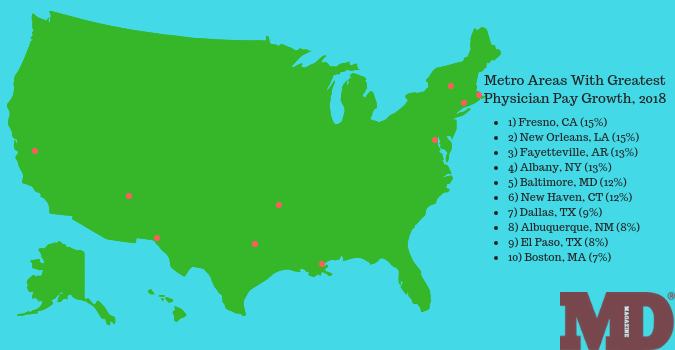Article
US Physician Job Demand Grows Again in 2018
Author(s):
Healthcare provider employment opportunies have risen 7.1%—an increase from 2017's reported rate of 5%. Where are the jobs in most demand?
The healthcare job market is still on the rise.
The US Physician Employment Report 2018, from clinician-centric social network Doximity, reported this morning that national physician employment opportunities have grown by 7% since last year—a steady increase from last year’s reported growth of 5.1%.
Investigators assessed approximately 8000 physician jobs posted on the site in 2017 and 2018, with data analyzed on 50 different metro areas and 15 different medical specialties—all included in the job postings. To analyze pay growth, they assessed the results from 70,000 self-reported surveys from full-time, licensed physicians and 7500 practicing nurses.
Projected continued job growth in the field through 2026 seems correlate with the Centers for Medicare & Medicaid (CMS) report that health spending will outpace Gross Domestic Product (GDP) through the same time span—physician and surgeon jobs are projected to grow 13% from 2016 to 2026, according to Doximity.
But physician shortages in the US continued to be a concern in light of this newest data. Doximity reported the medical specialties most in demand are, in order from most to less:
- Family medicine
- Internal medicine
- Emergency medicine
- Psychiatry
- Obstetrics & Gynecology
While the greatest specialties in need are also among the most common practices, the regions most in need of physicians are more particular. The 5 metro areas to have job growth reported as 17% or more are:
- Tuscon, AZ (20%)
- Los Angeles (19%)
- Chicago (19%)
- Little Rock, AK (18%)
- Baltimore (17%)

The regions with greatest pay growth for physicians in 2018 was similarly diverse. Six different metro areas reported pay growth greater than 10% in 2018:
- Fresno, CA (15%)
- New Orleans, LA (15%)
- Fayetteville, AR (13%)
- Albany, NY (13%)
- Baltimore, MD (12%)
- New Haven, CT (12%)
For the first time, Doximity included metrics for nurse practitioner (NP) specialty demands and pay growth by region. The specialties and locations were somewhat similar to those most prominent in the physician report: the greatest in-demand specialties for NPs were family, general, and adult care; the regions with greatest pay growth were Little Rock (15%), Des Moines, IA (14%), and Omaha, NE (14%).

In an interview with MD Magazine®, Amit Phull, MD, vice president of Strategy & Insights for Doximity, said the annual data sets could become part of a medical student’s career planning if they’re able to observe these trends of regional and positional demand.
“Within our shortage, there are many areas with growing need for workforce in medicine,” Phull said. “They represent same reality in any workforce, where there’s a lot of opportunity out there, and a need for supply to meet demand.”
Chris Whaley, PhD, lead author of the report and adjunct assistant professor at the University of California, Berkeley School of Public Health, told MD Mag this sort of regional and positional report is necessary for most fields—but has been mostly missing or misunderstood in healthcare.
“As we looked into this more, a lot of the stories we hear didn’t hold,” Whaley said. “In order to actually understand the market, you have to have data on the market.”
The investigators projected 2019 to bring along asymmetrical US physician demand and payment growth, with changes to federal, local, and private insurance policies influencing the market.
“Any change that could affect the total number of patients with access to healthcare or conversely, reimbursements for services, has the potential to result in flattening or declining compensation in local markets,” they wrote.
As Doximity continues to improve on its young series of annual reports, Phull expressed interest in observing state-by-state trends over time, observing for any adjustments made by the market to delegate “medical staffing and talent to the areas of demand.”
“It could be very informative to physicians coming into the workforce, as to how they’re going to approach and manage their own career,” Phull said.





